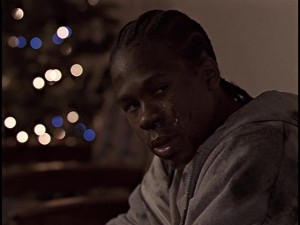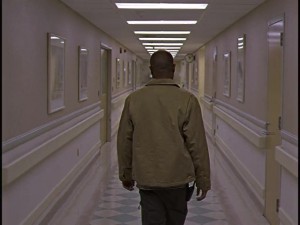Teaching The Wire
Jason Mittell
The most memorable moment in my 15-year teaching career thus far was 50 seconds of profound silence.
This silence followed the lights coming up after watching the 49th episode of The Wire, “That’s Got His Own,” the fourth season’s penultimate installment. The episode ends with a scene in a hospital, where Sergeant Carver goes to comfort and apologize to Randy, the middle schooler whom he’d promised to protect in exchange for providing information concerning a drug-related murder. Carver’s protection lapsed through an oversight, allowing the drug gang to punish snitching Randy by firebombing his foster mother’s house, who lies in critical condition with third degree burns. As Carver ineffectually assures the boy that things will be okay, a hardened Randy repeatedly taunts Carver as he walks down a lonely hospital hallway, “you gonna watch out for me now, Sergeant Carver?” as the credit music rises and the scene fades to black.

 Figures 1 and 2: Randy glares at Officer Carver with contempt, as he retreats into an institutional emptiness.
Figures 1 and 2: Randy glares at Officer Carver with contempt, as he retreats into an institutional emptiness.
This is a powerful moment portraying a likable character with tremendous promise destroyed by a broken system, conjuring a sense of inescapable hopelessness and cruelty that understandably left me and my thirty students shaken. What could we say that might intellectually engage with this trauma? How could we shift back to our comfortable classroom built of insulated privilege? But the lengthy silence stemmed from more than that one episode’s conclusion. It was the culmination of 49 hours of collective viewing over 10 weeks, as we all had watched The Wire together at a pace of five episodes each week. The dramatic and social weight of those 49 hours broke us collectively at the very same time, leaving a talkative class (and professor) speechless for almost a minute.
In retrospect, this moment confirmed that my pedagogical experiment was worth it. I launched my new course, “Watching The Wire: Urban America and Serial Television,” in Spring 2009 on something of a whim. The Wire ended its five season run in March 2008, and when I watched the final episodes, I experienced the blend of intellectual and emotional engagement that always prompts me to want to teach a film or other media text in a class. But given the program’s deep narrative continuities and long-form storytelling norms, any individual episode except the pilot is essentially incomprehensible outside of its broader serialized context. I am fortunate to teach at an institution where required course screenings are the norm, and I’d previously experimented with assigning weekly installments of a miniseries (The Singing Detective), and even a single season of an ongoing series (Six Feet Under), and was always gratified by how such serial structures create classroom community through shared experiences. But could I teach a 60-hour epic like The Wire?
I decided to take advantage of the freedom of tenure to give it a try, building a course around the series. At the time, I thought this was a completely original idea—I knew about courses focused around an individual series such as The Simpsons or Buffy the Vampire Slayer, but those classes sampled episodes rather than aiming for sequential comprehensive consumption. It turns out that my course on The Wire would be an early instance of a trend rather than an anomaly, as Linda Williams launched a similar course at Berkeley the same semester as mine, and numerous other campuses saw Wire-centered courses spring up over the next few years, often generating mystified journalistic reactions mulling “what they teach at colleges these days.”
My course differed from most of the other examples of Wire studies in two key ways. First off, I always foregrounded the program’s context as television. Most of the other Wire courses have been taught as interdisciplinary exercises outside of the terrain of media studies, popping up in departments like Anthropology, Urban Studies, Black Studies, Criminology, American Studies, Sociology, and Political Science. Such courses tend to treat The Wire as a document of real social conditions that serve as the intellectual material of the class—at their worst, they hardly even acknowledge the series as a work of televised fiction, centering solely on what it teaches us about contemporary urban America. My course certainly cares deeply about such social issues, and it is cross-listed in the American Studies program as an indication of its focus on The Wire’s content as a representation of contemporary America and its numerous social ills. But per the course subtitle, “Urban America and Serial Television,” and my own grounding in Film & Media Studies, I insist that my students must always remember that no matter what social truths The Wire might portray, it functions first and foremost as a fictional series produced and distributed by a massive media corporation. The course strives to toggle between these two perspectives: allowing The Wire to illuminate vital social issues and conditions, and critically engaging with how the text works as a television series whose content is always a representation, not a window to reality.[1]
While other film and media scholars share my emphasis on The Wire as television, I believe nobody else has taken up the structure implied by the course’s main title, “Watching The Wire”: the bulk of time spent together in the course is dedicated to actually watching the 60 hours of television that serve as the main course material. As with all things, context is vital, for it is only because I am at Middlebury College, a small and intensive residential institution, that I can schedule and require my students to spend so much time collectively watching the series. The schedule for each of the three times that I have taught the course consists of three weekly sessions: on Monday night, we watch two episodes together for two hours. On Tuesday and Thursday afternoons, we meet for two hours and forty-five minutes, allowing us to watch two episodes on one day, and one on the other—the five episodes each week maps perfectly with our twelve-week semester to cover the entire series. During afternoon sessions, we take a little time before viewing the episodes to discuss the series and our expectations and reactions; on the day we watch two episodes, we follow the screening with around 30 minutes of discussion, while the single episode meetings feature a full 75 minute discussion section diving deeply into issues from the series and the readings.
The decision to schedule screenings as class time was essential to me for a number of reasons. First off, it is the best way to ensure that students do not fall behind on the viewing, and are also watching episodes in a focused, non-distracted way. My departmental culture treats screenings as serious and required parts of courses, and modeling an engaged, attentive viewing process is one of the lessons we hope our students take away from our classes. These screenings are profoundly collective experiences, as students (and faculty) feel the dynamic of shared reactions and the energy that comes from that community practice, and can immediately compare reactions and launch into a conversation without having to remember what they may have watched some days earlier. While watching a television series on a large screen in a darkened theater is atypical, it does encourage students to pay close attention to visual and sonic elements as they do in a film course.
The course’s schedule also recreates something of The Wire’s original serial pace. Although watching a series that originally unspooled over six years over twelve weeks is a radical compression, the gaps between episodes are still more structured and mandated than how an individual might choose to burn through a viewing on DVD or streaming. Such gaps can be quite instructive: the course’s second week ends with a viewing of “The Cost,” which concludes with a chaotic scene of a botched police sting that results in a beloved police character getting shot and left bleeding in the backseat of a car. This is The Wire’s first and most affecting cliffhanger, and I force students to wait four days until they watch the next episodes to discover its resolution; such a serialized experience allows us to discuss the program’s narrative structure and how it both follows and diverges from televisual norms.
Our reaction to “That’s Got His Own” was partly born of that serialized structure, as we knew that we would need to wait two days before watching season four’s concluding episode, leaving us all to stew in our collective uncertainty over Randy’s fate. We also were reacting to one of The Wire’s intrinsic norms, where each season’s penultimate episode is written by George Pelacanos and features the program’s most heart-wrenching and traumatic events—before viewing these episodes, students would regularly posit what emotional gut-punches Pelacanos has in store for us this time. But even knowing that they were coming, the tragic deaths and disappointments of such episodes still hit me and my students hard, as they function as the culmination of serialized narrative build-ups that artfully convey the often senseless and seemingly avoidable traumas that structure the lives of the urban underclass portrayed on The Wire.
I do not remember what followed the silence on that day in 2009, aside from an acknowledgment that none of us knew what to say anymore. But I do remember that silence as both painful and profound, a learning experience that made my students truly aware of the potential power of serialized television drama, and the stark social realities that such a series might represent. I’ve taught the course two more times since that initial offering, and the reaction has never been the same—students are moved, but they are able to speak. I try not to be disappointed by such a reaction, but I definitely feel a twinge of regret that I cannot recreate that initial experience of collective silence. However, I have come to accept that the power of such moments is in their unpredictability, pedagogical experiences that cannot be planned as much as permitted to emerge from the unique contextual alchemy of any given course and combination of students. It is those unexpected moments of classroom experience that make the teaching of moving images so potent and powerful, especially via the collective ongoing structure of serialized television.
Jason Mittell is Professor of Film & Media Culture and American Studies, and Faculty Director of the Digital Liberal Arts Initiative at Middlebury College. He is the author of Genre & Television: From Cop Shows to Cartoons in American Culture (Routledge, 2004), Television & American Culture (Oxford UP, 2009), Complex Television: The Poetics of Contemporary Television Storytelling (NYU Press, 2015), and co-editor of How to Watch Television (NYU Press, 2013). He is project manager for [in]Transition: Journal of Videographic Film & Moving Image Studies.
Notes
[1] I have written about these televisual contexts in Jason Mittell, “The Wire in the Context of American Television,” in The Wire: Race, Class, and Genre, ed. Liam Kennedy and Stephen Shapiro (Ann Arbor: University of Michigan Press, 2012), 15–32, which is adapted from an essay I wrote for my students in this course.
